Snapdragons are stunning bedding plants that supply a long season of colourful flowers in all shades of pinks, reds, yellows and white. They are easy to grow, cheap to buy, and simple to propagate, making them perfect for any Australian border display.
I’ve been growing snapdragons ever since I was a kid, inspired by my grandparent’s bright and bawdy garden, packed with blousy bedding, and thankfully, my love of old-fashioned colour has come right back into fashion.
Here, I want to share all the growing tips I’ve learned, so you can grow snapdragons yourself, wherever you are in Australia.
More...
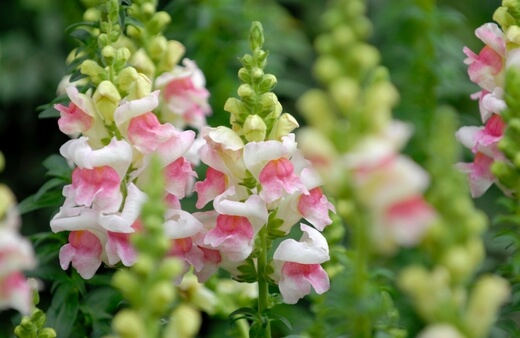
Family: | Plantaginaceae |
|---|---|
Genus: | Antirrhinum |
Common Names: | Snapdragons, dog flower, dragon flowers |
Location: | Outdoor |
Type: | Short-lived perennial |
Growth: | 15-45cm tall |
Sun requirements: | Full sun or light shade |
Foliage Colour: | Green |
Flower Colour: | Pinks, reds, oranges, whites, creams, and purples |
Flowering: | Spring to late summer |
Fruit: | None |
Maintenance level: | Low |
Poisonous for pets: | Non-toxic to cats and dogs |
What are Snapdragons?
Snapdragons are short-lived perennials, typically re-blooming for two to three years before they start to produce plain foliage, and very limited blooms, so you will need to plant fresh seeds every other year to keep a good supply of perfect flowers.
Their flowers develop on tall spikes, and repeat flower, similarly to foxgloves, in sequence along their flowering stem until they reach the top. At that point, you can simply deadhead them to encourage a fresh flush of flowers.
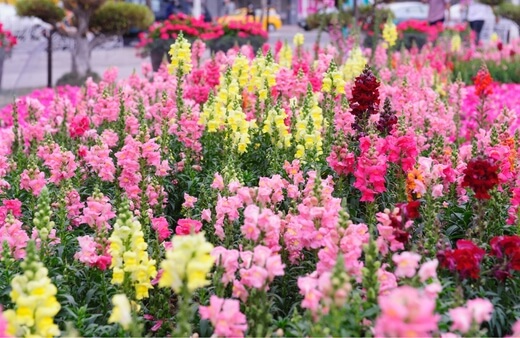
Natural Habitat of Antirrhinum
Snapdragons grow on rocky surfaces anywhere from North Africa to Canada, and are not particularly picky about temperatures. In cooler parts of the world though, they tend to be shorter-lived, and will usually self-seed faster in order to produce next year’s plants, rather than coming back year after year.
In nature, they are found in Canada, rocky parts of the US, North Africa, and even throughout Europe, proving that they are hardy enough for almost any climate.
Snapdragons will grow pretty much anywhere they can get a hold. Their fibrous roots are great at taking hold of any well-drained surface and will search for the water they need.
In our gardens though, they perform at their very best on rich, but free-draining soil. Higher nutrients produce more vibrant flowers, and more reliable bloom for longer in the year (typically from early spring right through to the end of summer).
The Best Snapdragon Varieties to Grow in Australia
1. Antirrhinum majus ‘Admiral White’ The F1 hybrid, Antirrhinum majus ‘Admiral White’, is a gorgeous pure white snapdragon, reaching up to 4ft tall. Unlike the typically dwarf bedding types, this snapdragon produces vivid displays that rival any tall flower spikes, with reliable summer-long flowers. | 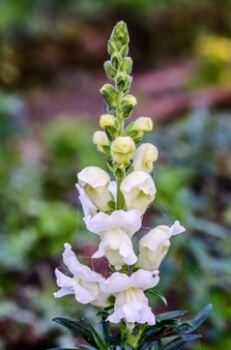 |
2. Antirrhinum majus ‘Aromas Magenta Mist’ The Aromas series isn’t limited to Magenta Mist, but there’s no other snapdragon that can produce this level of rich magenta for a summer border daily. These flower spikes reach 3ft in typically sandy soil, and 4ft in slightly richer compost, they are perfect for more shaded gardens provided they are well drained, and their inch-wide flowers are perfect for bees and butterflies. | 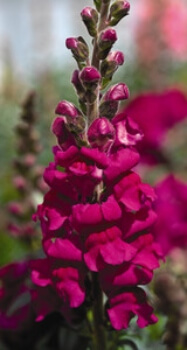 Source: Kurt Reynolds |
3. Antirrhinum majus ‘Black Prince’ OK, so it’s not black but the deep burgundy flowers of Black Prince are a beautiful addition to any container or garden bed. Their dense flower spikes rival salvias, with more dramatic height, and they are fairly reliable for non-sequential flowers - meaning they tend not to flower one by one, giving more impact sooner. | 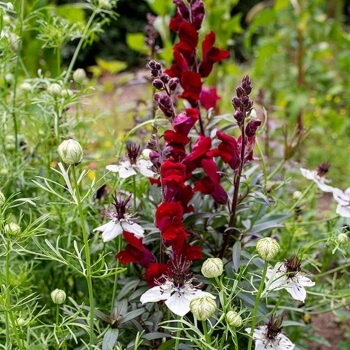 Source: Select Seeds |
4. Antirrhinum majus ‘Brighton Rock’ These mixed-coloured snapdragons are perfect for cottage garden planting, with surprising mixes of pinks, white, and creams, with gorgeously custardy yellow centres. They continue to flower even once cut, so are perfect for cut flowers and vase displays. | 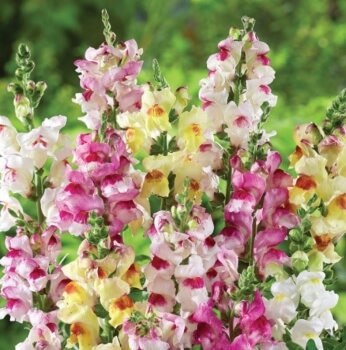 Source: Plants of Distinction |
5. Antirrhinum ‘Mini Butterflies’ These hybrid snapdragons are beautiful for pots and hanging baskets, reaching a dwarfed height of about 10” when in full flower. Their shorter flower spikes mean denser flowers and more work for deadheading, but it’s well worth it for these quaint little blooms in summer. | 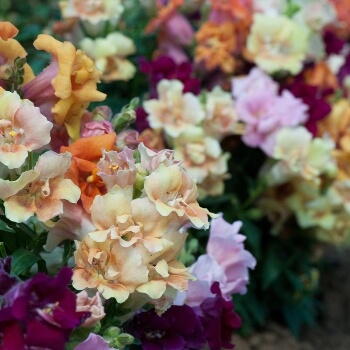 Source: Suttons |
6. Antirrhinum majus ‘Calima’ Calima is great for warmer parts of Australia, but should be treated very much as an annual in cooler parts of the country, and are unlikely to survive a frost. Their colours vary from white to bright pink, and their spikes can reach 3.5ft quite easily in most conditions. |  Source: Wellgrow Seeds |
7. Antirrhinum ‘Candelabra’ One of the best mid-height snapdragons has to be Candelabra. Its short but sweet stems are packed with mixed colours, and while they are typically matt colours, that means you get control over your borders, providing gorgeous blocky colours that you can plan around in the second year. | 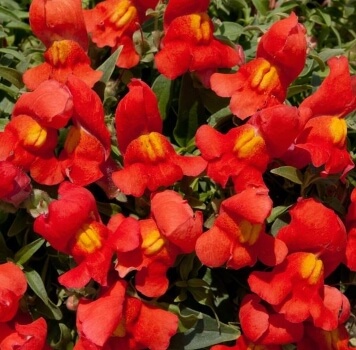 Source: Ball Seed |
8. Antirrhinum majus ‘Chantilly Bronze’ There are dozens of Chantilly varieties of snapdragon available, but none quite live up to Chantilly Bronze, with its peachy-bronze blooms that are reminiscent of cherry blossom, and work beautifully under planting fruit trees for exactly that reason, continuing spring blossom colours right through to late summer. | 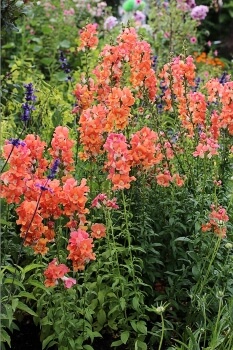 |
9. Antirrhinum majus ‘Costa’ The Costa series of snapdragons work wonderfully as short-lived perennials with a gentle colour across the entire range, and a very reliable height of 3ft (perfect for vases), but for me, it’s ‘Costa silver’ with its subtle pinks and purples that shimmer out in the evening, providing gorgeous scent, and beautifully specks of light reflecting back from the garden. | 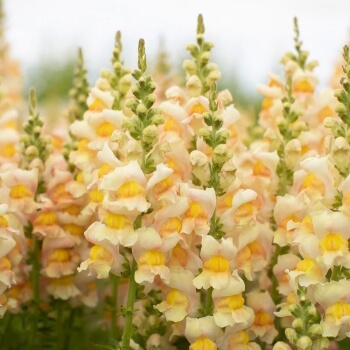 Source: Floret Flower Farm |
10. Antirrhinum majus ‘Floral Showers Deep Bronze’ Snapdragons are nearly all bred in ‘series’, so finding the right cultivar can be challenging. If you like shorter snapdragons without the dense blooms of mini-butterflies, try something looser like the Floral shower Series. If you want reliable warm colour at that height, choose Deep Bronze. There’s nothing quite like the fiery stubs of snapdragon ‘Floral Shower Deep Bronze’ to warm up a cool evening. | 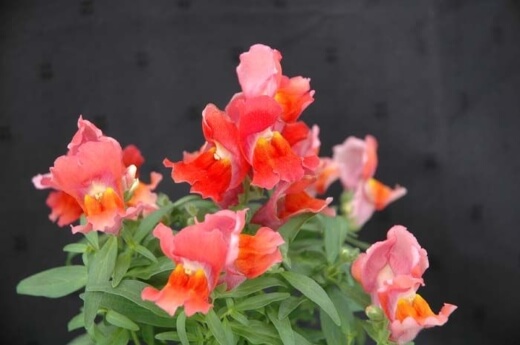 Source: Stokes Seeds |
11. Antirrhinum nanum ‘Frosted Flames’ Most snapdragons in cultivation are Antirrhinum majus varieties, but for more delicate foliage, and more of a focus on colour, try something different by growing Antirrhinum nanum species varieties. They are sold widely in garden centres as cheap plug plants in spring and make great bedding displays. | 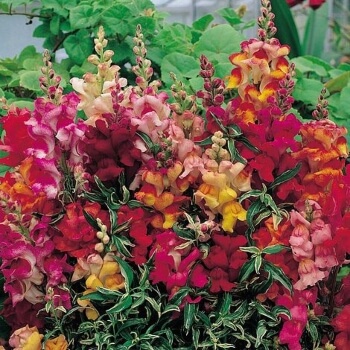 Source: Van Meuwen |
12. Antirrhinum majus ‘Liberty Series’ There’s no single snapdragon from the Liberty series that can be picked out as best, and in many ways it's best to just go for it with every colour you can with these blousy blooms. Just buy a liberty mix snapdragon seed packet and spread them through pots and hanging baskets for high-impact flowers which work well as short posies, or as a lower tier for cut flower displays. | 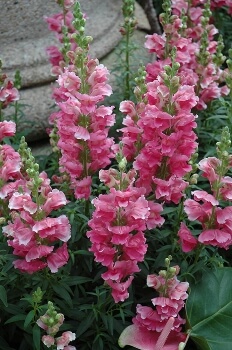 Source: Dutch Growers |
13. Antirrhinum majus ‘Lucky Lips’ I’m a sucker for any plant with lips in its name. The two-toned flowers are always stunning and pack more of a colour punch than monotone flowers. We’ve got Lucky Lips snapdragon planted in a repeating border with Salvia Hot Lips. For most of the spring, the snapdragons are the main performer, but as summer goes on, salvia hot lips and lavender take the stage and continue flowering into autumn. | 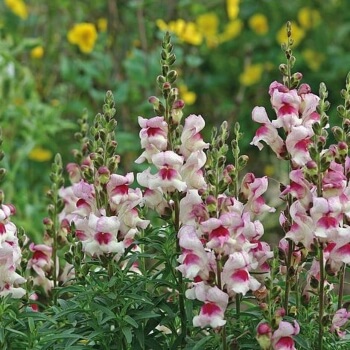 Source: Thompson & Morgan |
14. Antirrhinum majus ‘Madame Butterfly’ Double If you’re planning a wildlife garden, always avoid doubles, or plant them with a considered mix of open flowers. The visual impact of doubles is stunning, but they are largely inaccessible for pollinators, so should be planted in limitation as impact plants within a mixed border. |  Source: Chiltern Seeds |
15. Antirrhinum majus pumilum ‘Magic Carpet’ These ground-cover snapdragons are just dazzling. Planted in pots, hanging baskets, or borders they make the perfect bedding display. Their colours literally know no bounds, with mixed plants producing flowers in every shade of orange, yellow, white, and red, with bi-coloured petals and reliable flower spikes to boot. | 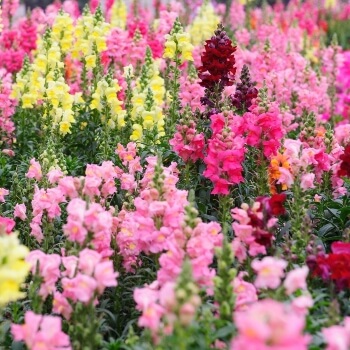 Source: The Seed Collection |
16. Antirrhinum majus maximum ‘Ruby Red’ As you can probably guess from the species name, these flowers are to the max. Their height is by far their most important feature, but that doesn’t stop them from producing dizzying crimson flowers which stand out beautifully against white borders for a burst of colour. |  Source: Bonanza |
17. Antirrhinum majus ‘Night And Day’ The bi-colour blooms of Night and Day Snapdragons are beautifully delicate but bold at the same time. Their creamy bases are paired with a deep scarlet petal, which pops out with a depth I’ve not seen in other cultivars, and they work well for late summer flowering. |  Source: RHS Plants |
18. Antirrhinum majus ‘Potomac Lavender’ Snapdragons are generally considered to come in red, white, yellow, orange, pink or cream, so the purple lavender tones of this Potomac series snapdragon are something to behold and a huge success in terms of breeding. For gardeners who prefer more subtle colours and want to avoid the 1970s-style blousy planting that most snapdragons afford, this has to be the perfect choice. |  Source: Johnny's Selected Seeds |
19. Antirrhinum majus ‘La Bella Red’ The open flowers of these wonderfully vivid snapdragons are perfect for pollinators and packed with interest. They flower on dense flower spikes, so make for good high-impact bedding and border plants, and reliably good flowers in their second year. | Cell |
20. Antirrhinum majus ‘Little Darling Mix’ Dwarf snapdragons, like Little Darling can put some gardeners off, but remember, gardening is all about layering. Creating tiers and levels of planting through pots, beds, and borders is important for a fuller display. Think about planting shorter, brighter, varieties like ‘Little Darling’ at the front of borders, with taller varieties as a third or even fourth tier near the back of herbaceous displays. | Cell |
1. Antirrhinum majus ‘Admiral White’

The F1 hybrid, Antirrhinum majus ‘Admiral White’, is a gorgeous pure white snapdragon, reaching up to 4ft tall. Unlike the typically dwarf bedding types, this snapdragon produces vivid displays that rival any tall flower spikes, with reliable summer-long flowers.
2. Antirrhinum majus ‘Aromas Magenta Mist’

Source: Kurt Reynolds
The Aromas series isn’t limited to Magenta Mist, but there’s no other snapdragon that can produce this level of rich magenta for a summer border daily. These flower spikes reach 3ft in typically sandy soil, and 4ft in slightly richer compost, they are perfect for more shaded gardens provided they are well drained, and their inch-wide flowers are perfect for bees and butterflies.


Get Your Free Guide:
Master Growing Australian Natives eBook
A Must Have Complete Guide for Every Australian Garden
Get Your Free Guide:
Master Growing Australian Natives eBook
A Must Have Complete Guide for Every Australian Garden
3. Antirrhinum majus ‘Black Prince’

Source: Select Seeds
OK, so it’s not black but the deep burgundy flowers of Black Prince are a beautiful addition to any container or garden bed. Their dense flower spikes rival salvias, with more dramatic height, and they are fairly reliable for non-sequential flowers - meaning they tend not to flower one by one, giving more impact sooner.
4. Antirrhinum majus ‘Brighton Rock’

Source: Plants of Distinction
These mixed-coloured snapdragons are perfect for cottage garden planting, with surprising mixes of pinks, white, and creams, with gorgeously custardy yellow centres. They continue to flower even once cut, so are perfect for cut flowers and vase displays.
5. Antirrhinum ‘Mini Butterflies’

Source: Suttons
These hybrid snapdragons are beautiful for pots and hanging baskets, reaching a dwarfed height of about 10” when in full flower. Their shorter flower spikes mean denser flowers and more work for deadheading, but it’s well worth it for these quaint little blooms in summer.
6. Antirrhinum majus ‘Calima’

Source: Wellgrow Seeds
Calima is great for warmer parts of Australia, but should be treated very much as an annual in cooler parts of the country, and are unlikely to survive a frost. Their colours vary from white to bright pink, and their spikes can reach 3.5ft quite easily in most conditions.
7. Antirrhinum ‘Candelabra’

Source: Ball Seed
One of the best mid-height snapdragons has to be Candelabra. Its short but sweet stems are packed with mixed colours, and while they are typically matt colours, that means you get control over your borders, providing gorgeous blocky colours that you can plan around in the second year.
8. Antirrhinum majus ‘Chantilly Bronze’

There are dozens of Chantilly varieties of snapdragon available, but none quite live up to Chantilly Bronze, with its peachy-bronze blooms that are reminiscent of cherry blossom, and work beautifully under planting fruit trees for exactly that reason, continuing spring blossom colours right through to late summer.
9. Antirrhinum majus ‘Costa’

Source: Floret Flower Farm
The Costa series of snapdragons work wonderfully as short-lived perennials with a gentle colour across the entire range, and a very reliable height of 3ft (perfect for vases), but for me, it’s ‘Costa silver’ with its subtle pinks and purples that shimmer out in the evening, providing gorgeous scent, and beautifully specks of light reflecting back from the garden.
10. Antirrhinum majus ‘Floral Showers Deep Bronze’

Source: Stokes Seeds
Snapdragons are nearly all bred in ‘series’, so finding the right cultivar can be challenging. If you like shorter snapdragons without the dense blooms of mini-butterflies, try something looser like the Floral shower Series.
If you want reliable warm colour at that height, choose Deep Bronze. There’s nothing quite like the fiery stubs of snapdragon ‘Floral Shower Deep Bronze’ to warm up a cool evening.
11. Antirrhinum nanum ‘Frosted Flames’

Source: Van Meuwen
Most snapdragons in cultivation are Antirrhinum majus varieties, but for more delicate foliage, and more of a focus on colour, try something different by growing Antirrhinum nanum species varieties.
They are sold widely in garden centres as cheap plug plants in spring and make great bedding displays.
12. Antirrhinum majus ‘Liberty Series’

Source: Dutch Growers
There’s no single snapdragon from the Liberty series that can be picked out as best, and in many ways it's best to just go for it with every colour you can with these blousy blooms.
Just buy a liberty mix snapdragon seed packet and spread them through pots and hanging baskets for high-impact flowers which work well as short posies, or as a lower tier for cut flower displays.
13. Antirrhinum majus ‘Lucky Lips’

Source: Thompson & Morgan
I’m a sucker for any plant with lips in its name. The two-toned flowers are always stunning and pack more of a colour punch than monotone flowers. We’ve got Lucky Lips snapdragon planted in a repeating border with Salvia Hot Lips.
For most of the spring, the snapdragons are the main performer, but as summer goes on, salvia hot lips and lavender take the stage and continue flowering into autumn.
14. Antirrhinum majus ‘Madame Butterfly’ Double

Source: Chiltern Seeds
If you’re planning a wildlife garden, always avoid doubles, or plant them with a considered mix of open flowers. The visual impact of doubles is stunning, but they are largely inaccessible for pollinators, so should be planted in limitation as impact plants within a mixed border.
15. Antirrhinum majus pumilum ‘Magic Carpet’

Source: The Seed Collection
These ground-cover snapdragons are just dazzling. Planted in pots, hanging baskets, or borders they make the perfect bedding display. Their colours literally know no bounds, with mixed plants producing flowers in every shade of orange, yellow, white, and red, with bi-coloured petals and reliable flower spikes to boot.
16. Antirrhinum majus maximum ‘Ruby Red’

Source: Bonanza
As you can probably guess from the species name, these flowers are to the max. Their height is by far their most important feature, but that doesn’t stop them from producing dizzying crimson flowers which stand out beautifully against white borders for a burst of colour.
17. Antirrhinum majus ‘Night And Day’

Source: RHS Plants
The bi-colour blooms of Night and Day Snapdragons are beautifully delicate but bold at the same time. Their creamy bases are paired with a deep scarlet petal, which pops out with a depth I’ve not seen in other cultivars, and they work well for late summer flowering.
18. Antirrhinum majus ‘Potomac Lavender’

Source: Johnny's Selected Seeds
Snapdragons are generally considered to come in red, white, yellow, orange, pink or cream, so the purple lavender tones of this Potomac series snapdragon are something to behold and a huge success in terms of breeding.
For gardeners who prefer more subtle colours and want to avoid the 1970s-style blousy planting that most snapdragons afford, this has to be the perfect choice.
19. Antirrhinum majus ‘La Bella Red’
The open flowers of these wonderfully vivid snapdragons are perfect for pollinators and packed with interest. They flower on dense flower spikes, so make for good high-impact bedding and border plants, and reliably good flowers in their second year.
20. Antirrhinum majus ‘Little Darling Mix’
Dwarf snapdragons, like Little Darling can put some gardeners off, but remember, gardening is all about layering. Creating tiers and levels of planting through pots, beds, and borders is important for a fuller display.
Think about planting shorter, brighter, varieties like ‘Little Darling’ at the front of borders, with taller varieties as a third or even fourth tier near the back of herbaceous displays.
Growing Snapdragons in Australia
Snapdragons grow on any free-draining soil, and prefer full sun if you can provide it. In part shade, they perform well but will take longer to flower, and tend to stop flowering slightly earlier, so you will usually get a midsummer display.
How to Plant Snapdragons
Snapdragons are best planted from seed, as you can produce dozens of plants for higher impact gardening, but if you don’t have space, they are affordable from garden centres as plug plants in spring, or slightly more mature packs in late spring, ready to plant straight into any pot, basket, or border.
Follow our tips below to get the right soil, sun, and moisture for snapdragons.
Soil and drainage
Plant snapdragons on free-draining compost without too much moisture-retentive material. If you’re planting in fresh compost add at least 50% grit, vermiculite, perlite, or sand to the mix so that they are never left sitting in water. Moist soil won’t kill them, but it will stunt their development.
Watering Snapdragons
Water snapdragons on free-draining soil at least once a week. Think about their native environments; typically high up, rocky spaces, in full sun, with plenty of natural cloud humidity, and easy access to rainfall; but, rainfall that drains away very quickly.
Watering snapdragons thoroughly once a week is usually enough to keep them happy and healthy but, in full summer sun, they should be watered a little more often if their soil is drying out completely.
Light and Temperature
Aim for full sun, where snapdragons benefit from rapid photosynthesis, and flower faster. Effectively, what you’re doing by providing higher light levels is increasing the temperature sooner than in nature, provoking a flush of flowers as the plants try to set seed.
This gives a longer flowering time but does mean you’ll have to deadhead flower spikes as soon as they finish so the plant doesn’t put all of its energy into producing seed.
In late summer, stop deadheading so that the plant has time to develop seeds that you can harvest and re-sow next year.
How to Grow Snapdragons in Pots
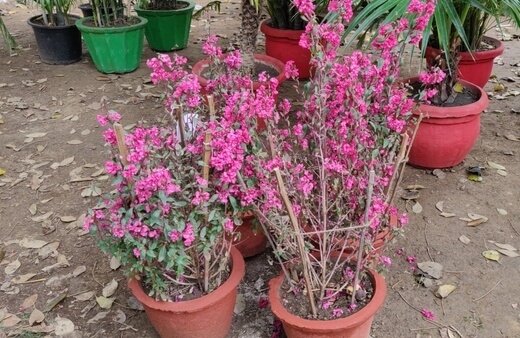
Snapdragons grow beautifully in pots and containers, where drainage is typically better than in the ground. You have more control over where to plant them and can move the pots around the garden to make the most of the changing summer sun.
Even hanging baskets make great homes for snapdragons, which are perfectly happy in the free-draining conditions, and won’t take as much water as more traditional basket plants like violas and alyssum.
Propagating Snapdragons
Snapdragons grow wonderfully from seed and are super easy to propagate. I was about eight years old when I grew my first snapdragons from seed, and they thrived. It’s hard to make sense of memories from that age, but I’m sure it had a big impact on my future life as a gardener.
If you want to double your stock later in the year, you can take cuttings from snapdragons in spring, or even in early autumn when flowering has finished. Check my guide below for exactly how and when to propagate snapdragons using both methods.
Snapdragon Propagation from Seeds
Snapdragons are short-lived perennials, so saving seeds and sowing them later is a great way to create a beautiful garden on a budget. Start by leaving your final flush of flowers to go to seed in late summer.
When the seed pods turn brown and dry, collect them by placing a paper bag over the stem, then cutting it at the base. Turn it upside down for a week, and as it dries, the seeds will naturally fall into the bag. They can be propagated and overwintered in greenhouses, or stored in cool, dry conditions, over winter to sow in late winter.
When the last frost has passed and daylight hours are at about 8-10 in late winter, or early spring for some of southern Australia, simply fill a seed tray with loose, sieved compost and a healthy handful of perlite to aid drainage. Then thinly sow snapdragon seeds across the surface.
After 1-2 weeks you’ll have dozens of seedlings over the soil. Keep them moist, warm, and in bright but indirect light for a few more weeks until they develop proper foliage and are large enough to handle, then prick them out into individual pots.
Propagating Snapdragons from Cuttings
Snapdragon cuttings are so easy to take in spring, or even autumn after flowering has finished. If you’ve ever taken perennial cuttings like this, from plants like verbena, you’ll know the score.
Essentially, any stem that hasn’t had a flower, or has no signs of flowering, with foliage at its tip, is the perfect cutting material. The sturdier the better. Cut stems as far down as possible, taking a tiny wick of the stem it was attached to. This wick will include a node, and loads of hormones, ready to root.
Place the cutting straight into clean soil or compost, and keep it humid by covering it with a bag or propagator lid. It will begin to root after about two weeks.
Note: unlike most cuttings, there’s no need to remove the leaves from snapdragon stems. Their foliage will usually die back while rooting, so don’t be discouraged. As long as the stem stays green and sturdy you’ve got a good chance of success.
Caring for Snapdragons
Snapdragons take very little care once they’ve established, and will regrow for a couple of years without intervention. If you want to make the most of them though, there are some useful tricks I use to give them a boost in spring.
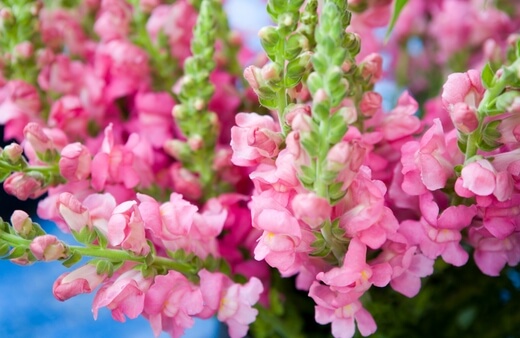
Mulching Snapdragons
Snapdragons don’t need a mulch, but they do benefit from it. In late winter, when the foliage has mostly browned off, mulch around the base of each plant with a light layer of fresh compost.
This isn’t to keep them warm, or even to keep moisture in, but simply to add nutrients. Alternatively, you can use fertiliser granules.
Best Fertiliser for Snapdragons
The best fertilisers for snapdragons are bloom-boosting granules. Miracle-Gro does a brilliant range of basic garden fertilisers, and their bright colours make them simple to manage.
Remember that these are long-flowering plants, so slow release is the name of the game.
For me, that means granules every time, but I know there are more religiously organic gardeners out there who will swear by liquid seaweed fertiliser for all of their flowering bedding plants, and the benefits are the same; it’s just a lot more effort as you’ll need to feed them once a fortnight at least to get the same benefits.
Deadheading
By far the most important part of snapdragon care is deadheading, and knowing when to do it. Snapdragons flower in sequence up their flower stem, or flower spike. This means that at first, you’ll have a stubby spike, with a few flowers around the base, and more developing as the lower flowers drop off.
In cooler climates, you might well get full flower spikes all at once, but it’s unlikely in most Australian gardens.
When the flower spike has finished flowering, or there is just one group of flowers left at the tip, cut the spike right back to the next stem. This will encourage new spikes, and can be the difference between 4 weeks of flowering and 16 weeks of flowering.
When to Replant Snapdragons
Snapdragons are short-lived perennials. That means they can come back for up to three years in full colour. More realistically, two years will see full performance, and in their third, the plants will start to fade.
For me, that means that it’s essential to sow new snapdragon seeds every two years (or, buy new plants if you fancy a more laid-back approach to gardening).
Dragon Flower Pests and Diseases
Snapdragons tend not to suffer from many pests, and diseases tend to be few and far between. Even in moist soil they will continue growing without signs of root rot, but they will perform slightly worse.
That said, it’s still important to keep an eye out for particularly bad infestations of aphids, fungus gnats, or thrips, which can spread fungal disease from any other herbaceous plant, and don’t get lazy with moisture control as they might not be regular rotters, but root rot can still set in in extremely damp conditions.
Snapdragons Frequently Asked Questions
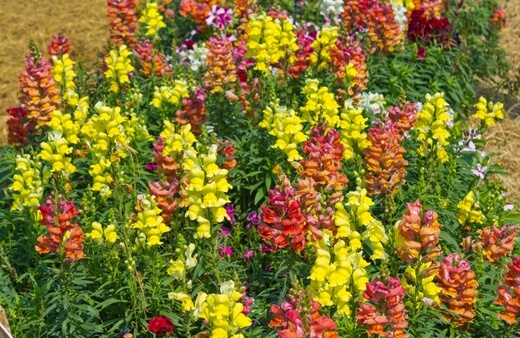
Are snapdragon flowers edible?
Snapdragon flowers are completely edible and have a beautifully delicate sweetness that works perfectly in salads. They’re not nutritious enough to provide a full meal, but to garnish desserts and salads, they are a wonderful thing to grow alongside a veggie patch.
While the foliage isn’t poisonous, it’s not particularly flavourful either, so stick to the flowers to avoid disappointment!
Can snapdragons be annual?
While snapdragons are perennials, they are often treated as annual plants. Not because of hardiness, or cold sensitivity, but because their vibrance and vigour fades after two or three years.
For some gardens that means planting them freshly every year. For me, I tend to stick to once every two years.
Do snapdragons self-seed?
While I prefer to grow snapdragons from seed manually, that’s more about the control it provides over garden design. For a more natural garden, snapdragons can be relied on to self-seed within a few metres of their original position.
Their seeds will begin to develop in autumn and winter, and flower in the second year through spring and summer.
Do snapdragons rebloom if you cut them back?
Snapdragons are best deadheaded carefully, spike by spike, for a neater effect, but if you’re into the ‘Chelsea Chop’ style of gardening, they can be cut right to the ground after flowering in mid-summer to encourage a fresh flush of growth, which reinvigorates the plant completely.
If you do treat them this way though, it’s best to treat them as annuals and replant them each year.
Should you cut snapdragons back for winter?
Snapdragons should be cut back for winter to prevent any overly damp conditions from rotting their top growth. In really cold climates with a risk of frost, the safest way to treat them through winter is to move their pots inside but, again, it’s worth re-sowing each year in these sorts of conditions.
Do snapdragons need to be deadheaded?
Deadheading snapdragons keeps them flowering for longer in the year, but it won’t make them any more or less healthy, no no they don't need to be deadheaded, but yes, they do benefit from it.
For a longer flush of flowers in summer deadheading is generally good practice for snapdragons and most other perennial bedding plants.
Are snapdragons poisonous?
Not only are snapdragons not poisonous but they can be used to garnish salads. They have a slightly sweet flavour and should be used with care as consuming too many will give you an upset stomach. So only use them as a garnish for cakes or salads.
Are snapdragons the same as dog flowers?
Snapdragons and dog flowers are the same plants, and both names arose from the same visual traits. When snapdragons are squeezed from the side, they open and close their mouths, loosely resembling the face of a dog or dragon.
Do snapdragons smell?
Snapdragons have rich nectar but a weak scent, however, their unique aroma is particularly good for attracting pollinators and bees to the garden. Like all long-lobed flowers, they are ideal for a wide range of birds and insects, all of which are attracted to the fragrance.
Do snapdragons spread?
Snapdragons are generally planted as annuals as they can be badly affected by prolonged frosts, but in warmer climates, they do spread quite easily from seeds. Rather than spreading out in clumps, their seeds are dispersed by wind, making them a great addition to warm climates and wildlife gardens.
Do bunnies eat snapdragons?
If your garden has rabbits or any small mammals, snapdragons are a great way to keep the colour without risking your prized blooms being eaten. Snapdragons are nontoxic to most animals but have a particularly unpleasant taste for rabbits, who will steer clear after one bite.
What is killing my snapdragons?
Snapdragons are pretty resilient against pests, but slugs and snails will devour their lower leaves if they get a chance, so lay egg shells around the base of your post to discourage them.
The calcium in the egg shells will also help to reduce the risk of antirrhinum rust, which is the most common disease in snapdragons.
Wrapping Up Our Snapdragons Growing and Care Guide
Snapdragons have a special place in my heart, and always will, but with all of my emotional bias to one side, they are still a gorgeous perennial that will provide spring and summer colour in almost any Australian garden.
Yes, they have limitations, and preferences, but even if you don’t; meet their every need, they will perform well and are always worth growing. Even if you’ve got a shaded garden, growing snapdragons is always possible in Australia, so give it a go.
Published on December 14, 2022 by Maisie Blevins
Last Updated on December 5, 2024




